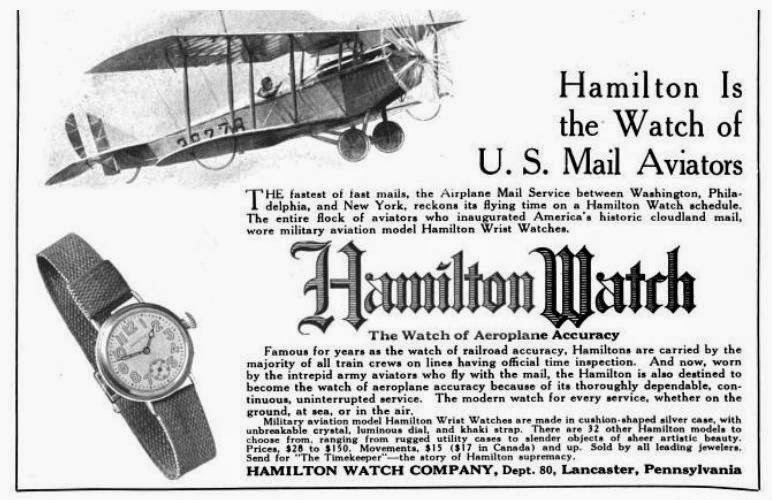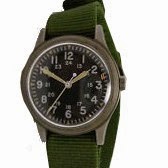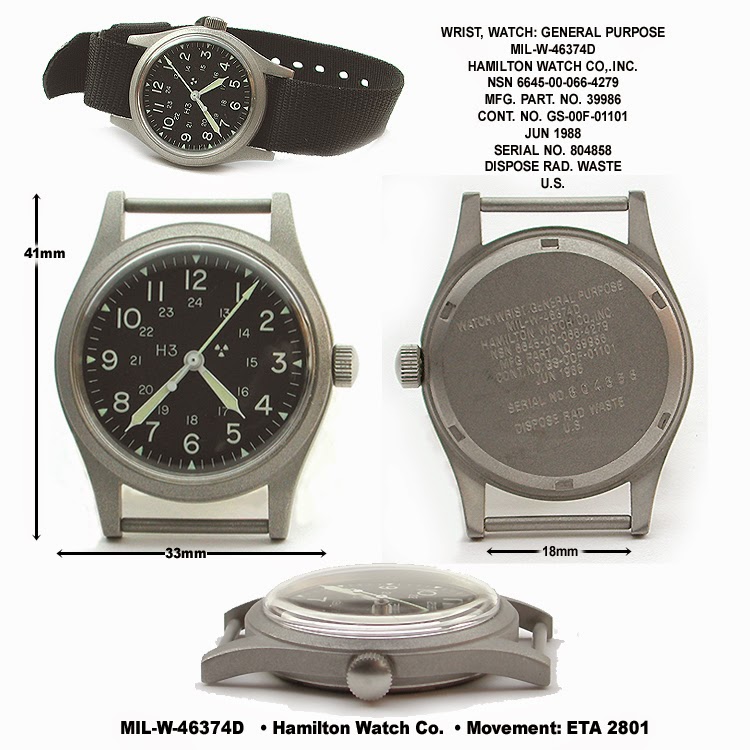In 1980 Hamilton founded the Collector’s Classic Edition Society (CCES).
Hamilton developed its first collectible wristwatch for CCES a standard military wristwatch, re-christened the “Khaki.” An outsider saw military models on the assembly line. He suggested that Hamilton’s G.I. watches might make attractive consumer items.
He commented that old army watches were considered very chic and that hip young New Yorkers were calling them “guerilla fashion.”
The “Khaki” was a sell-out at Bloomingdale’s and, encouraged by this success,
Zanowski and Robertson presented it to L. L. Bean. Bean responded positively
and included it in their Fall 1981 catalog.
Made to strict U.S. military specifications, the “Khaki” was – and still is rugged
and reliable, a perfect fit in L. L. Bean’s outdoorsy array. But Bean did
not have an exclusive. CCES offered it direct to consumers with two nylon
straps, one olive drab and one khaki, and stowed it in a miniature “duffel bag”
and “foot locker.”
A Time for America – Don Sauers (deceased) 1992
Hamilton Watch Company supplied the US Military and its allies with timepieces for over 70 years from 1917 to 1989. They provided wrist and pocket watches, Marine chronometers, aviation equipment and instrumentation. Of Hamilton’s four lines of business, defense contracting provided a reliable and significant income stream.
When the Berlin Wall fell in November 1989, Hamilton’s defense business fell with it. The end of the Cold War slowed defense spending dramatically.
 Tensions between the US and Russia ceased. Military spending decreased as much as 90%.
Tensions between the US and Russia ceased. Military spending decreased as much as 90%.
Hamilton’s last contract with the US military ended in 1988 leaving the company with a massive infrastructure for producing military watches and no orders.
Hamilton’s parent, the Swatch Group, Ltd. made a bold and incredibly successful move by transforming military watches into consumer products. They named the watches Khaki and Nicolas G. Hayek, had another global product to add to his arsenal of successful timepieces.
If you have any doubt about military roots of the Hamilton Khaki line, look at the three watches below. The Hamilton Khaki image in the middle appears in the current catalog (2015). The hostile parties of the cold war stopped producing various timepieces for the military. NATO last requisitions used ETA quartz movements. The one to the right uses an ETA 2801.
The image below the watches shows the US Military’s specifications for the last Hamilton Military model.
|
|
|
||||||
|
Background
Hamilton entered the defense industry in 1917 when the US military designated the company as the official watchmaker of the US Army. Much speculation exists about how many watches the company produced in the World War I era. We do have records of a trench watch containing one inch (0-sized) 17-jewel 983 movements. Production ceased in 1918 and totaled 6900 units.
Soldiers gave Hamilton military watches the khaki nickname. In the advertisement above entitled Hamilton is the Watch of U.S. Mail Aviators, the company touts its association with the US Mail. Toward the bottom the ad reads:
Military Aviation model Hamilton Wristwatches are made in cushion-shaped silver cases with unbreakable crystal, luminous dials and khaki straps.
Gallery – Early Hamilton Khaki with Dimensions comparable to last watches made for the US Military. This model has a 38-inch case. Hamilton also reversed the dial colors by the imprint process – a simple procedure. We refer to this as an RAF model, because the British used it for pilots.
The band is the official NATO color – gray. These photos are not in black and white; the photographers used a digital camera in super-micro mode.
Hamilton started making watches for the US Military before the attack on Pearl Harbor in December 1941. Star Case Manufacturing Company won the contract to adapt the Hamilton Endicott case for use in warfare. Contrary to many beliefs, stainless steel was available for watches. In 1929, before the Great Depression hit, over 25,000 tons of stainless steel were manufactured and sold in the US. The army chose stainless steel for their military watches with a brushed finish.
Hamilton and Star had a two-year head start on other US watch manufacturers. In essence, Hamilton produced a majority of the watches used by the Allies.
Given the events that brought us the Khaki watch, I find it interesting that 75 years after the Hamilton Endicott watch came to market in 1937, it’s still one of the most popular watch styles ever made.
Copyright 2006-2017 | All Rights Reserved



